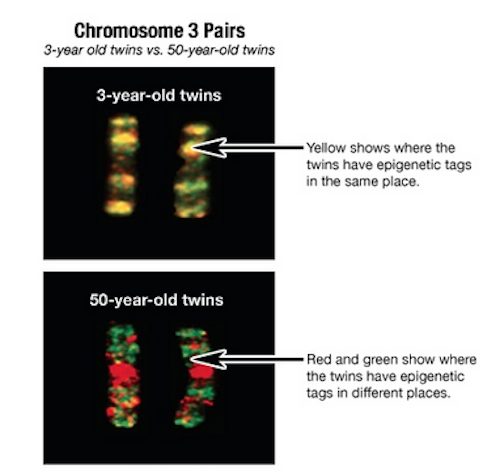Aging Plasticity Puts You In Control of How You Age

Aging plasticity is a thing. It means that your destiny is shaped not by your genes, but by your epigenome. When it comes to how well you age, or not, you’re in the driver’s seat. Learn why and take control. (Watch the video!)

This post is an abridged version of "Step 1" from my forthcoming course, The Ageproof Method: 14 Steps to a Long and Strong Life. Get the 14 Step Checklist here.
From time to time, I’m going to post abridged versions of the transcripts from a video course I’ve been working on for longer than I care to admit.
This post is about “Step 1”, which is the foundation upon which every other step is built. It’s the foundation, because Step 1 is about the science of epigenetics, and epigenetics is about how you determine how you age.
What you’ll learn in Step 1:
- Specific “Hallmarks of Aging” identify the mechanisms of aging plasticity that identify how and why we age.
- DNA is the blueprint of life, but it is not your destiny. Genetics is not destiny — your epigenome is, and much of that is within the span of your control.
- Identical twins are born with the same DNA. Twenty, 40, or 70 years later, they still have the same DNA, but may have aged very differently, and that’s because of epigenetics.
Let’s dig in…
The Mechanisms of Aging Plasticity
In 2013 a Spanish scientist named Carlos López-Otín and his associates published a paper about the nine Hallmarks of Aging in an attempt to define the mechanisms that cause aging.
This paper and the nine “Hallmarks” are still referenced today as the bedrock reasons behind aging, even though in subsequent years, scientists have come up with five more. And perhaps by the time you read this, more will be added, combined or even dropped; such is the way of scientific inquiry, especially when it comes to the complexity of aging.
If you’d like to delve into the mechanisms behind aging that the Hallmarks describe, check out my three-part series on the topic:
- Part 1, The New Hallmarks of Aging: Why You Age describes the 14 Hallmarks of Aging, giving you insights about the biological mechanisms behind aging.
- Part 2, Cell Chatter: The Critical Role of Cell Signaling in Aging, explores how the cells “speak” to the biological processes that constitute the aging hallmarks, and why they, in effect, start to slur over time, adding to the aging process.
- Part 3, The Four Horsemen of Disease: The Impact of Aging Hallmarks and Signaling Dysfunction connects the dots between the Hallmarks, cellular signaling and the creation of major age-related diseases that, one or more of which eventually kill us.
All of this is complicated, and yet has one important bedrock attribute, and that is: aging is plastic. What that means is the aging process is malleable; it’s largely determined by the lifestyle choices you make.
Yes, you would think that how you age is predetermined by your genetics, but your genome — the complete set of genes or genetic material present in a cell or organism — only accounts for about 25% of how you age. The rest, that 75%, is highly influenced by how various lifestyle factors shape the expression of genes; in effect, whether they’re expressed (“turned on”), or dormant (“turned off”).
The silencing or activation of gene expression is the realm of the epigenome.
Epigenetics Puts You In The Driver’s Seat
“Epi” is derived from the Greek word epi, which literally means “above”, or “on top”, and indeed that is the province of the epigenome — it, in effect, exists on top of the genome. Its existence is made up of chemical compounds that modify, or mark, the genome in a way that tells it what to do, where to do it, and when to do it.
Different cells have different epigenetic tags (or “marks”). This is where “aging plasticity” comes to bear, because it’s your lifestyle choices that make the marks along the epigenome that turn your gene expression on and off, about which I’ll have more to say later.
How this all happens, this aging plasticity, is the purview of epigenetics.
Epigenetics is the study of potentially heritable changes in gene expression and phenotype that occur without alterations in the DNA sequence, as facilitated by mechanisms such as DNA methylation, histone modifications, and RNA-silencing tags that either silence or activate gene expression:
- DNA methylation is the addition of methyl groups to DNA, which can silence or activate gene expression.
- Histone modifications are the chemical changes to histone proteins that DNA wraps around, affecting how tightly or loosely the DNA is packaged and influencing gene accessibility. It can either silence or activate gene expression.
- RNA-silencing refers to RNAs that do not code for proteins (what they usually do), but rather regulate gene expression by binding to other RNAs or chromatin. (Basically, chromatin is the compact packaging of DNA and protein in the nucleus of cells.) As the name suggests, RNA-silencing molecules inhibit or silence gene expression.
The genome can be visually represented like this:


So, to sum up the sciency stuff:
- Gene activation allows transcription and protein production*
- Gene silencing blocks or suppresses transcription
- Histone modifications can either activate or silence, depending on the specific mark
- RNA-silencing suppresses gene expression
(*Gene activation enables transcription of the gene’s DNA into mRNA, which then leads to translation of that mRNA into the encoded protein. Without gene activation, the gene remains silenced, and its encoded protein cannot be produced in the cell.)
How epigenetics works is much less important than what it means, because what it means is that how you age is largely within the span of your control. Lifestyle factors such as diet, exercise, stress, sleep, your environment — these choices dictate how well or poorly you age. These things puts you in the driver’s seat.
It’s why identical twins can age very differently.
Why Twins Grow Apart
Identical twins are called “identical” because their DNA is the same. They begin their life journey looking something like this:

But there are many miles in life’s journey, and things change, even for identical twins. They can grow apart, because different lifestyle choices can make their respective epigenomes different. And that becomes evident in their phenotypes.
Eventually, twins can grow apart:

Lifestyle and environmental factors can alter the height of one identical twin relative to the other.

Lifestyle and environmental factors can alter the body composition of one identical twin relative to the other.
Now please understand that I’m not doing any fat-shaming here. It’s just that differences in body composition are obvious, whereas some differences between twins such as cholesterol or blood sugar would not be visually obvious.
Height is also obvious. As you can see, the identical twin males pictured above are no longer identical, as expressed by height.
The reasons identical twins can grow apart is because DNA does not rule over gene expression. As you’ve learned, when it comes to aging, DNA (the genome) takes a backseat to your epigenome. And you shape it.
Twins grow apart, even if identical, because their respective epigenome changes as they get older if they adopt different lifestyles. Remember, this occurs based upon how gene expression is regulated (turned on and off) by those epigenetic “tags” discussed above. They regulate gene expression by acting as gatekeepers, blocking or allowing access to a gene’s ‘on’ switch.
At birth identical twins emerge from the womb with the same DNA, and when they go to their graves, they have the same DNA. But in between those two poles, they live their lives, and those lives are not identical. They can be dramatically different.
The more those identical twins live their lives differently, the greater will be the difference in their respective gene expression. That’s because their respective epigenome will be shaped differently given their lifestyle choices. And so, even though they are born with and die with the same DNA, they do not leave this world with the same epigenome.
Epigenetic twin studies demonstrate how the epigenome can change gene expression, and thereby change how people with identical genetics — twins — experience life.
Twin Studies Reveal the Impact of Epigenetics
Studies on identical twins have done much to identify a number of behavioral traits and diseases that are likely to have a genetic component, and others that are more strongly influenced by the environment. This makes them an excellent model by which to measure how genes and the environment contribute to certain traits, especially complex behaviors and diseases.
When just one twin gets a disease, researchers can look for different elements in their respective environments and behaviors. Such observations are collected from large numbers of twin studies and help pinpoint the molecular mechanism of a disease and determine the extent of environmental influence, potentially leading to the prevention and treatment of complex diseases.
We know from twin studies that your lifestyle choices matter a great deal to how healthy you are physically and mentally as you get older. And to make that clear as a bell, watch this short animated youtube video that does a great job of showing and explaining why identical twins grow apart. It’s called What Is Epigenetics:
Check out these pictures that compare three year-old twins to 50 year-old twins to see the stark contrast in how many epigenetic tags show up in different places along their respective chromosomes as they aged:

This picture above shows chromosome pairs in each set of twins that are digitally superimposed. One twin’s epigenetic tags are dyed red and the other twin’s tags are dyed green. When red and green overlap, that region shows up as yellow. You can see that the 50-year old twins have more epigenetic tags in different places than do 3-year-old twins.
The reason that 50-year old twins have more epigenetic tags than the 3-year olds is because they lived longer, and during those years were able to make many more and different lifestyle choices that are observable by those epigenetic tags that occur in different places along their chromosomes.
Yes, they share the same genes, but as identical twins grow up and move apart, they grow apart, because their environments become dissimilar, as do their lifestyle factors, both of which affect gene expression.
There’s a saying in the field of genetics that goes like this: Genetics loads the gun, but behavior pulls the trigger.
And now you have a pretty good idea about how this happens. Hopefully it’s now abundantly clear that what we do, what we eat, whether we exercise or not, our stress level and sleeping patterns — they, and many other things, affect gene expression, for better or worse.
So, now that you’ve taken Step 1, and realize that you can affect how you age, what’s next? Well, what’s next is Step 2. Go here and get the at get your checklist of the 14 steps to a long and strong life.
Last Updated on April 27, 2024 by Joe Garma


